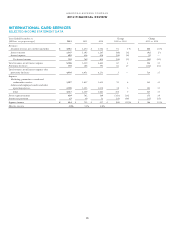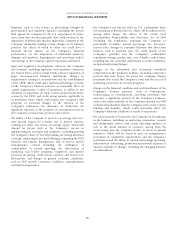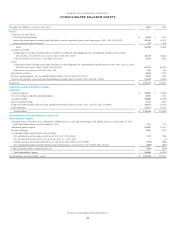American Express 2012 Annual Report Download - page 57
Download and view the complete annual report
Please find page 57 of the 2012 American Express annual report below. You can navigate through the pages in the report by either clicking on the pages listed below, or by using the keyword search tool below to find specific information within the annual report.AMERICAN EXPRESS COMPANY
2012 FINANCIAL REVIEW
폷litigation, such as class actions or proceedings brought by
governmental and regulatory agencies (including the lawsuit
filed against the Company by the U.S. Department of Justice
and certain state attorneys general), that could result in (i) the
imposition of behavioral remedies against the Company or the
Company voluntarily making certain changes to its business
practices, the effects of which in either case could have a
material adverse impact on the Company’s financial
performance; (ii) the imposition of substantial monetary
damages and penalties, disgorgement and restitution; and/or
(iii) damage to the Company’s global reputation and brand;
폷legal and regulatory developments wherever the Company
does business, including legislative and regulatory reforms in
the United States, such as Dodd-Frank’s stricter regulation of
large, interconnected financial institutions; changes in
requirements relating to securitization and the establishment
of the CFPB, which could make fundamental changes to many
of the Company’s business practices or materially affect its
capital requirements, results of operations, or ability to pay
dividends or repurchase its stock; actions and potential future
actions by the FDIC and credit rating agencies applicable to
securitization trusts, which could impact the Company’s ABS
program; or potential changes to the taxation of the
Company’s businesses, the allowance of deductions for
significant expenses, or the incidence of consumption taxes on
the Company’s transactions, products and services;
폷the ability of the Company to meet its on-average and over-
time growth targets for revenues net of interest expense,
earnings per share and return on average equity, which will
depend on factors such as the Company’s success in
implementing its strategies and initiatives, including growing
the Company’s share of overall spending, increasing merchant
coverage, enhancing its pre-paid offerings, expanding the GNS
business and expense management, and on factors outside
management’s control including the willingness of
cardmembers to sustain spending, the effectiveness of
marketing and loyalty programs, regulatory and market
pressures on pricing, credit trends, currency and interest rate
fluctuations, and changes in general economic conditions,
such as GDP growth, consumer confidence, unemployment
and the housing market;
폷the Company’s net interest yield on U.S. cardmember loans
not remaining at historical levels, which will be influenced by,
among other things, the effects of the Credit Card
Accountability Responsibility and Disclosure Act of 2009
(including the regulations requiring the Company to
periodically reevaluate annual percentage rate increases),
interest rates, changes in consumer behavior that affect loan
balances, such as paydown rates, the credit quality of the
Company’s portfolio and the Company’s cardmember
acquisition strategy, product mix, cost of funds, credit actions,
including line size and other adjustments to credit availability,
and potential pricing changes;
폷changes in the substantial and increasing worldwide
competition in the payments industry, including competitive
pressure that may impact the prices the Company charges
merchants that accept the Company’s cards and the success of
marketing, promotion or rewards programs;
폷changes in the financial condition and creditworthiness of the
Company’s business partners, such as bankruptcies,
restructurings or consolidations, involving merchants that
represent a significant portion of the Company’s business,
such as the airline industry, or the Company’s partners in GNS
or financial institutions that the Company relies on for routine
funding and liquidity, which could materially affect the
Company’s financial condition or results of operations;
폷theactualamounttobespentbytheCompanyoninvestments
in the business, including on marketing, promotion, rewards
and cardmember services and certain operating expenses, as
well as the actual amount of resources arising from the
restructuring plan the Company decides to invest in growth
initiatives, which will be based in part on management’s
assessment of competitive opportunities and the Company’s
performance and the ability to control and manage operating,
infrastructure, advertising, promotion and rewards expenses as
business expands or changes, including the changing behavior
of cardmembers;
55
























